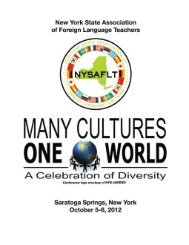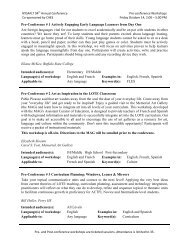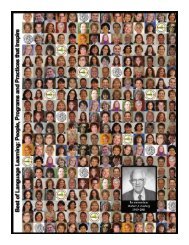THE COMPLETE CURRICULUM Ensuring a Place for the Arts and ...
THE COMPLETE CURRICULUM Ensuring a Place for the Arts and ...
THE COMPLETE CURRICULUM Ensuring a Place for the Arts and ...
- No tags were found...
Create successful ePaper yourself
Turn your PDF publications into a flip-book with our unique Google optimized e-Paper software.
NASBE<strong>THE</strong> <strong>COMPLETE</strong> <strong>CURRICULUM</strong><strong>the</strong> Elementary <strong>and</strong> SecondaryEducation Act. Thus, NCLBempowers states <strong>and</strong> schools tofocus on a well-rounded, comprehensiveeducation, which in turnallows states to reevaluate <strong>the</strong>irpolicy frameworks—includingaccountability structures—<strong>for</strong> allcore subject areas.Specific to assessment, policy canbe developed in a variety of ways tomeet <strong>the</strong> needs of an individual state.For example, states <strong>and</strong> local districtscould <strong>for</strong>m regional coalitions tohelp alleviate <strong>the</strong> expense of testdevelopment. A policy could also beadopted that would allow localdistricts to use state-approvedassessments—regardless of whodeveloped <strong>the</strong>m. Ano<strong>the</strong>r optionwould be to allow <strong>for</strong> local schooldistricts or regional consortia todetermine <strong>the</strong> most effectivemethods <strong>for</strong> assessing students,whe<strong>the</strong>r it is per<strong>for</strong>mance tasks orportfolios. Regardless of <strong>the</strong> optionthat best suits a particular state’sneeds, <strong>the</strong> important factor is toalign any assessment measures withstate st<strong>and</strong>ards, curriculum frameworks,or o<strong>the</strong>r requirements.The grade levels of <strong>the</strong> assessmentsare also an important consideration<strong>for</strong> policymakers. Oneoption <strong>for</strong> states to consider is todevelop <strong>and</strong> administer assessmentsat <strong>the</strong> 8th grade, as a way of maintaining<strong>and</strong> building K-8 programs<strong>for</strong> all students. This would incorporate<strong>the</strong> earlier discussions on <strong>the</strong>importance of early learning in <strong>the</strong>arts <strong>and</strong> <strong>for</strong>eign languages. Statesthat already test students in <strong>the</strong>eighth grade in many curricular areasmay want to opt <strong>for</strong> ano<strong>the</strong>r grade<strong>for</strong> assessing students in <strong>the</strong> arts <strong>and</strong><strong>for</strong>eign languages.Texas Musicians to <strong>the</strong> RescueIn Texas, music powerhouses have come toge<strong>the</strong>r to address budgetcuts in <strong>the</strong> arts. The Texas Music Project, a nonprofit organization tha<strong>the</strong>lps raise funds <strong>for</strong> school music programs across <strong>the</strong> state, recentlylaunched a public awareness campaign that includes <strong>the</strong> sale of a CDseries. The CD contains songs from big-name artists such as WillieNelson, Erykah Badu, <strong>and</strong> <strong>the</strong> Dixie Chicks, <strong>and</strong> all proceeds from <strong>the</strong>sale of <strong>the</strong> CD, called Don’t Mess With Texas Music, will be used tosupport music education programs throughout <strong>the</strong> state. The project isbeing supported by more than 30 music <strong>and</strong> arts organizations, as well asa host of musical artists. More in<strong>for</strong>mation on <strong>the</strong> project can be foundonline at www.texasmusicproject.org.States should also consider o<strong>the</strong>rpossible accountability measures asalternatives to assessment. Programmonitoring is one option, as isrequired reporting. States that movein this direction would need to havestrong policy in place in order tomonitor compliance.Recommendation 9: Urge <strong>the</strong>National Assessment GoverningBoard to increase <strong>the</strong> frequencyin <strong>the</strong> administration of NAEPassessments <strong>for</strong> both <strong>the</strong> arts <strong>and</strong><strong>for</strong>eign languages.Both <strong>the</strong> arts <strong>and</strong> <strong>for</strong>eignlanguages have NAEP assessments(<strong>for</strong>eign language is in <strong>the</strong> pilotstage). Contrasting <strong>the</strong> frequencywith which NAEP is assessed inma<strong>the</strong>matics, compared with <strong>the</strong> arts,<strong>for</strong> example, has sent a less thanencouraging signal to <strong>the</strong> states about<strong>the</strong> importance of <strong>the</strong> arts as a coresubject. It also reduces <strong>the</strong> potentialthat states will benefit from <strong>the</strong>release of test items, results ofvalidity <strong>and</strong> reliability field tests ofassessment exercises, <strong>and</strong> o<strong>the</strong>r waysin which <strong>the</strong> federal-state relationshipworks <strong>for</strong> math, reading, writing, <strong>and</strong>science in large-scale assessment.FundingFunding is a cornerstone of everystate <strong>and</strong> local educational system, aswell as <strong>for</strong> every curricular area. Inthat regard, <strong>the</strong> arts <strong>and</strong> <strong>for</strong>eignlanguages are no different. However,competition with o<strong>the</strong>r core areas hasalso placed arts <strong>and</strong> <strong>for</strong>eign languageprograms low in <strong>the</strong> pecking order<strong>for</strong> funding.Recommendation 10: UrgeCongress <strong>and</strong> legislatures to makea greater commitment to <strong>the</strong> arts<strong>and</strong> <strong>for</strong>eign languages.At <strong>the</strong> federal level, <strong>the</strong> NationalEndowment <strong>for</strong> <strong>the</strong> <strong>Arts</strong> (NEA) <strong>and</strong><strong>the</strong> National Endowment <strong>for</strong> <strong>the</strong>Humanities (NEH) are two federalagencies that support <strong>the</strong>se areas.Congress created both in 1965 asindependent agencies of <strong>the</strong> federalgovernment. Funding <strong>for</strong> <strong>the</strong> eachagency hovers around $125 million. Instark contrast, <strong>the</strong> funding level <strong>for</strong> <strong>the</strong>National Science Foundation (NSF)hovers around $5 billion—with around$1 billion going toward K-16 activities.The Department of Educationalso provides minimal funding24






